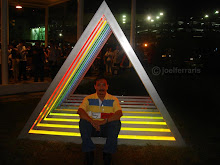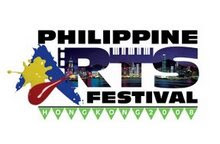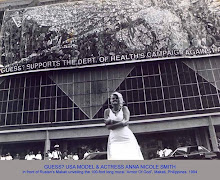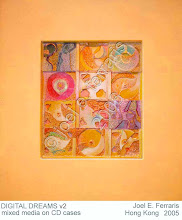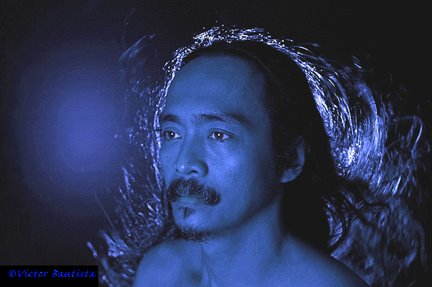
(You, Me and Our Environment) Artist: NELSON FERRARIS
Artist's statement:
Masks unmask all hidden truths. Faces tell tales and face-off stories unfolded between man and nature. Faces speak a thousand words. What you see is what you get.
What the faces express reflects the kind of environment that certainly influences and affects their existence. Inevitably, man’s voracious and vicious ways brought disastrous results to nature. Surely nature in return, and with vengeance, retaliates with more devastating and violent forces that man could ever imagine.
An eye for an eye, a tooth for a tooth. What you sow is what you reap. It is a karmic principle maybe but scientifically and precisely calculated that man’s destructive attitude towards nature expects more havoc in greater heights against man in return. This will be goodbye to our beloved Mother Nature and welcome to the "UPHOLSTERED DREAM", a new horizon under the sun.
Man and nature must co-exist harmoniously and symbiotically. A give and take, take and give system in life might work out and respect, understanding and protection to our surrounding natural ecology could nourish better human ecology and safer place to live in… or just simply call this "HOME."
A review of "Ikaw, Ako at ang Ating Kapaligiran"
By Joel Ferraris
This humongous wall art installation reveals a mural consisted of huge paper mache masks and was exhibited in the first solo art exhibition of Artist Nelson Ferraris at the spacious Pasilyo Carlos V. Francisco of the Cultural Center of the Philippines in Roxas Boulevard, Manila in 1990. This same piece was reinstalled in Iloilo City in Western Visayas, Philippines, as part of “Hublag 4”, the Fourth Ilonggo Arts Festival at the Philippine National Bank (PNB) lobby in this city.
Seeing it first-hand, I was greeted by an array of large-sized, 3-dimensional masks projecting various facial expressions that were cleverly done. These are all integral parts of a visual statement heralding an imminent threat to the environment caused by the carelessness and excesses of man in his continued exploration, exploitation and abuse of the earth’s natural resources in unceasing efforts fueling the seemingly untiring advancement of civilization.
Nelson Ferraris, a consistent prize-winner in numerous art competitions, painted on each of these masks symbols which are a combination of the alibata script and other graphic forms that, from a recognizable distance, reveal the bigger picture and send messages of the past beauty of nature colliding with the existing environmental situation that we are seemed to be captives of.
Equally symbolized and emphasized in this mural is hope, represented by blank, white-colored masks, on which rests the future of the generations to come. Whatever that means to a growing secular world, hope is generally spiritual in a sense as the artist meant it to be and as represented by the purity of white.
The whole piece is divided into three parts where the overall combination was made possible by the distinction between symbols, images, colors and facial expressions in a variety of emotions used in representing the past, the present and the dream of a better and more spiritually enlightened future.
Visually arresting because of its sheer size, this huge art piece, arranged as dictated by the juxtaposition of all its elements, was made more dramatized in depth and volume by the interplay of artificial lights and shadows inside the Cultural Center of the Philippines in Manila and the natural ambient light in the semi-outdoor lobby setting of Philippine National Bank (PNB) in Iloilo City. The many faces in various facial expressions were exceedingly dwarfed by but reminiscent of those giant faces of great men in Mt. Rushmore but here the use of eye-catching colored images and symbols painted over almost all of them made all the masks combined to look somewhat like a huge, painted canvas.
Done in 1990 and made possible by a grant from the Cultural Center of the Philippines, this large piece of public art was meant to draw attention to an imminent environmental threat in the midst of a lot of urbanization fast creeping into the lush-green countryside. It was also to make people more aware of subtle but serious issues about global warming which were given more in-depth scrutiny with the release of the movie “An Inconvenient Truth” featuring Al Gore that repeatedly sent strong messages to induce chilling sensations up and down our spines every time disturbing and destructive natural calamities alter the fast pace of this age of digital technology or by simply at the thought of it.
The issue about environmental protection continues to draw opposing views. Steven Hayward’s “An Inconvenient Truth... or Convenient Fiction?” offers equally thought-provoking questions. Nevertheless, this and other points of view from experts around the world combined only make the threat, or the absence of it, more magnified to compel people to reflect on what the real truth is apart from the thought on how to spend the rest of our short lives.
It is therefore the thoughtful reflection and message through this significant public art piece of Nelson Ferraris that will inspire us to look beyond the issue about our material concerns, human survival and the fate of this world to instead focus our minds and hearts to the importance of our spiritual life, a sentiment shared by the artist, in preparation for the blissful afterlife in Eternity.
* * * * * * * * * * * * * * * * * * * * * ** * * *
You can find a much clearer photo of "Ikaw, Ako at ang Ating Kapaligiran" (when this public art was installed at the Philippine National Bank Iloilo Branch lobby as the centerpiece of the "Hublag 4" Ilonggo Arts Festival) on page 138 of ILOILO: The Book, a photographic essay by Iloilo's leading photographers published by Ms. Marite de Luzuriaga in 1992.
You can view Nelson E. Ferraris' CV here.



